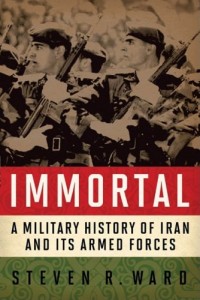|
Reviewed by Wyndham Whynot, Ph.D., Assistant Professor of History, Livingstone College The military forces and exploits of the armies of Alexander the Great, the Romans and the Ottomans are well known in the West. Yet few are familiar with the lengthy military history of the Iranian empires–the Achaemenians, Parthians, Sassanians, and Safavids—despite the fact that throughout history they controlled significant portions of southwest Asia and other territories. Fortunately, Steven Ward’s Immortal, a comprehensive study of Iran’s armed forces from Cyrus to the early twenty-first century, provides a good starting point for those seeking to learn more about the history of the Iranian military. A United States intelligence analyst of the Middle East, Ward provides a well written and in-depth overview of the history and development of the various military forces of each Iranian civilization and/or empire up to the present era. He argues that the relative poor performance of Iran’s armed forces in recent times is due more to mismanagement, poor leadership, and other factors, than the abilities and willingness of Iranians to defend their nation; according to Ward, this fact should serve as a cautionary tale for any nations that may consider a future conflict with Iran. Immortal begins with an examination of what Ward refers to as “Fortress Iran,” the country’s mountain ranges, high seasonal temperatures, swampy areas, and limited coastline that have served as a defensive barrier throughout its history. (p. 7.) Ward argues even modern military forces attacking Iran would face tremendous difficulties, as the terrain favors a defensive and guerilla style of warfare—which Iran’s military has refined throughout the country’s history. From here, he moves into an analysis of ancient Persian and early Iranian armies from the beginnings of the Achaemenian period through the Safavid Empires, providing a detailed account of early Iranian warfare, noting Parthian and Sassanian cavalry forces were capable of defeating Roman armies while the Safavid Empire played a significant role in limiting the Ottoman Empire’s expansion through Asia. Ward spends the remaining two-thirds of the book discussing Iran’s military in the modern era. He notes how Russia and Great Britain tried to assist the Qajar Dynasty’s efforts to modernize their armed forces, only to have Qajar rulers and significant Iranian military leaders often undercut reform and modernization efforts. Widespread corruption, the rise of “personal” armies, the failure to pay soldiers, and concerns expressed by religious authorities about “westernization” all played a role in limiting meaningful reform efforts during that dynasty’s rule. Transformation of Iran’s forces faced similar obstacles after the crushing blow by the British and Russian invasion during World War II. Iran’s military grew at an unprecedented rate on paper, yet failed to effectively modernize and reform, primarily due to Mohammad-Reza Shah Pahlavi’s micromanagement of the armed forces. His policies laid the way for the success of the Iranian Revolution, as the military lacked the tools and personnel to stop the revolution. Between 1979 and the early 2000s, Iran gradually became a major political and military power in the Middle East. Taking a more aggressive posture in its quest to become a nuclear nation, Iran’s growing military power and political influence within the Middle East has come under considerable scrutiny by Western powers in the last decade. To help guide readers through the important points in the book’s chapters, Immortal includes eleven maps depicting geography, the extent of Iranian empires, and major operations. One minor criticism worth noting is that Ward’s decision not to include any photographs or pictures, which would have helped familiarize readers with the players, the make-up of the forces through the years and the equipment they employed. While a minor criticism, such illustrations could have been useful to readers new to the subject. It would serve well anyone closely following the developments in the present diplomatic row between Iran and the West to read Immortal. It is an excellent overview of Iran’s military history—a comprehensive examination of their military forces from which both specialists and generalists can benefit. One can only envision the work Ward may have produced had he not been confined by the limitations placed on him as a federal employee; however the wealth of information he was able to provide is an excellent resource for those seeking to understand the country’s military in a historical context. |


 Immortal: A Military History of Iran and Its Armed Forces
Immortal: A Military History of Iran and Its Armed Forces
